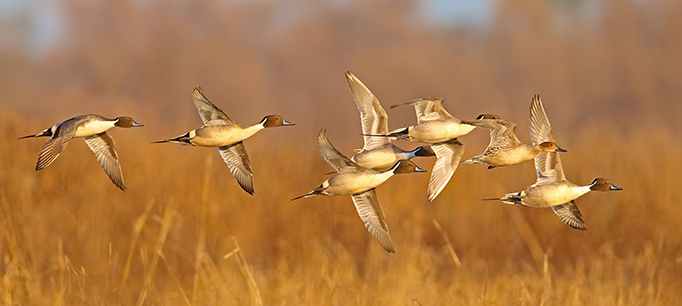California has lost 95% of its natural wetlands. Managing what’s left is complicated by inadequate water and infrastructure. We talked to Ric Ortega, general manager for the Grassland Water District in the San Joaquin Valley, on what is needed to maintain wetlands in this difficult environment.
 PPIC: What are California’s biggest challenges for managing wetlands?
PPIC: What are California’s biggest challenges for managing wetlands?
Ric Ortega: About 25 years ago Congress directed the US Department of the Interior and the state to provide adequate, reliable water to the last remaining wetlands in California. But on average, only half of the spring and summer water required to meet the needs of wildlife is delivered. Drought years are far worse with most habitat remaining dry.
Remarkably, even the water that is available can’t always be delivered to the habitat. To mitigate for the impact of building the federal Central Valley Project, 19 wildlife refuges were established. Currently, five of the 19 refuges don’t have infrastructure in place to receive the water that is allocated to them.
Sadly, 14 refuges south of the Delta—including ours—are chronically short of water. It’s also getting more difficult to move refuge water supply through the Delta on a schedule that the wildlife requires. Maintaining timely Delta exports to refuges is critical, especially in drought years.
PPIC: What is your district doing to improve ecosystem conditions?
RO: The Grassland Ecological Area is home to the largest remaining block of wetlands in the west. It supports 300 species of birds, many of which overwinter and breed here. Our biggest challenge is delivering adequate water to the habitat when the plants and animals need it.
In good water years, we basically have to farm the remaining habitat to feed the 10 million birds that move through the Central Valley along the Pacific Flyway each year. What I mean by that is we try to maximize the productivity of the marsh, and that starts with growing the grasses that produce food for the birds. We need adequate spring and summer water to grow those grasses and provide breeding habitat.
Private landowners in our district manage their habitat to produce crops of beneficial food plants for migratory waterfowl. These efforts also benefit many other species—for example, the threatened giant garter snake and the endangered tri-colored blackbird. We work closely with farmers and partner groups like the California Waterfowl Association and Ducks Unlimited to leverage grant funding and share costs for habitat restoration projects and water supply improvements. And we work closely with organizations like Audubon and the Nature Conservancy to provide specific habitat for shorebirds and song birds at the right times of the year.
PPIC: What changes are affecting how your district manages water for ecosystems?
RO: Funding is becoming a larger problem. The cost of buying and moving water has skyrocketed―our conveyance fees tripled during the drought. We rely on a “restoration fund” managed by the US Bureau of Reclamation. They use some of this to acquire water from willing sellers and also to deliver that water to the habitat. The fund also provides a vital revenue stream to our local economy—about $15 million goes to local agricultural districts that sell and move water to state, federal, and private refuges.
Implementation of the Proposition 1 water bond will be a huge step forward for California wetlands. It included $89 million to help build needed infrastructure so all refuges can receive their water supply. The water storage portion of the bond also has some projects that could help wildlife.
Our refuge’s water system is intricately linked with local agricultural water supply. As farmers get more efficient with their water use, less farm runoff is making it to the refuges. Also, with less water moving through the system, water quality degrades. We need to manage our water resources more in line with the hydrologic conditions at hand. Water conservation is paramount in dry times, but in wet years we should promote more flood irrigation to recharge the aquifer, spill into the marshes, and flush salts from the basins. We also need more flexibility to move environmental water around the state to support wildlife and the Pacific Flyway.
Learn more
Read Reforming Water Management for the Environment (PPIC Blog)
Watch a panel discussion on partnerships for healthy ecosystems (with Ric Ortega)
Visit the PPIC Water Policy Center’s ecosystems resource page


